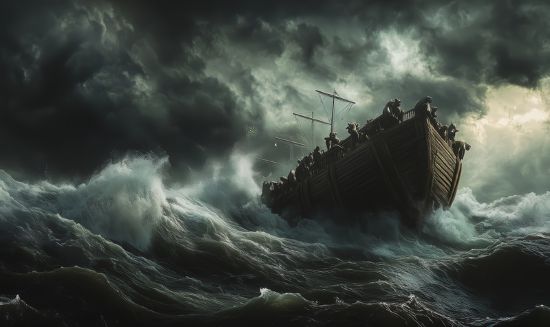I have just been reading about the Zanclean megaflood which filled the Mediterranean Sea over a 2 to 16-year period. This happened 5.6 million years ago. There were no human witnesses to have this event imprinted on our collective memory. However, many other flood events have happened before history was recorded and more than one may be linked to the biblical flood described in the Old Testament.
If you are not familiar with the Zanclean megaflood, it occurred during a period known as the Messinian Salinity Crisis when the Mediterranean was cut off from the Atlantic Ocean and evaporated leaving vast salt deposits.
In 2009, an extensive erosion channel was discovered on the seafloor stretching from the Atlantic Ocean through the Straits of Gibraltar well into the Mediterranean Sea basin. Researchers concluded that this channel could only have been formed by a megaflood event. Based on their findings, the volume of flood water coursing through the channel reached one million cubic metres per second (approximately 15.8 million gallons per second). That’s a lot of water, and as you can imagine would have significantly altered the physical shorelines and features within the Mediterranean. No one was around to see it and tell their children so the Zanclean cannot have spawned the Noah story.
A more likely candidate is one that Robert Ballard, the discoverer of the wreck of the Titanic, believes could be the origin of the Noah story. In his exploration of the Mediterranean and the Black Sea, he found evidence to support a megaflood that was first proposed in 1998 and later described in a 2003 article appearing in Earth and Planetary Sciences entitled, Catastrophic flooding of the Black Sea.
A December 2012, article written by Rhonda Moniz for Marine Technology News has Ballard describing what he found below the surface of the Black Sea. There were ancient shorelines under 121 metres (400 feet) of water. He stated:
“We went in there to look for the flood, not just a slow-moving advancing rise of sea level, but a really big flood that then stayed. The land that went under stayed under. It probably was a bad day, at some magic moment, it broke through and flooded this place violently, and a lot of real estate, 150,000 square kilometres of land, went under.”
Revised data indicates the Black Sea megaflood occurred between 5600 and 6800 BCE, dates that certainly fulfill the theory that storytelling by human tribes passed down through generations could be the source of the Noah flood.
There could be another flood story linked to Noah. The people of Mesopotamia including early Hebrew tribes have The Epic of Gilgamesh, a story that includes an epic flood caused by the gods that left archeological traces of a flooding event happening around 1,800 BCE. The story includes a boat that saved humanity.
Flood mythology can be found everywhere from Pacific Ocean islands to China, India, and Africa. Greek mythology tells the story of a flood that Zeus sent to destroy the world. In it, Prometheus, known for giving humans the secret of fire, is described as the saviour of humanity. Prometheus’ sacrifice is said to have had some influence on early Christian storytelling related to the crucifixion.
Here in North America flood mythology appears to have geohistorical roots related to megaflood events occurring at the end of the last Ice Age. A series of these happened with Lake Agassiz, a glacial lake that repeatedly formed and then drained lying to the west of where the Great Lakes are today. Agassiz flood events happened between 12,000 and 8,500 years ago as North American glaciers advanced and repeatedly melted. The last event released a megaflood through the St. Lawrence and Hudson River Valleys to the North Atlantic Ocean and caused dramatic changes in prehistoric Europe’s climate. Those Agassiz floods may have been recorded in the oral tradition of the Lakota people of the Great Plains which tell the story of a water monster, Unktehi, who drowned the villages of its people.
Flooding mythology today is a subset of anthropology called geomythology. A good article describing this subset is Geomythology: Can geologists relate ancient stories of great floods to real events? It appeared in the newsmagazine, The Conversation, in 2016.









